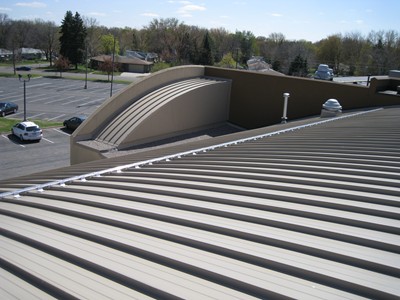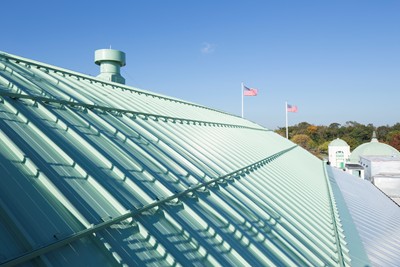 By John Pierson, PE, The Garland Co. Inc.
By John Pierson, PE, The Garland Co. Inc.
The architectural application of metal is limitless. I remember the few products we had in the late '90s, trying to gain traction in the construction market place. It is exciting to see an enormous growth in the use of metal products. One unfortunate by-product of this enormous growth is a lack of understanding for what metal products are watertight, and those that are well...not.
Of course, metal roofs are only as watertight as their seams, and details. Structural standing seam metal roofs are really the only systems that can be relied upon to be watertight at the panel seam in most applications. Structural standing seam metal roofs, in general, are characterized by 2” or higher seams, mechanical field seaming of the panels, factory-applied, high-quality seam sealants, and use a clip attachment that allows thermal movement. These are all characteristics that allow these panels to span open framing and stay watertight. It’s important to remember that architectural standing seam roofing usually relies on an underlayment for its waterproofing.
 Here is a brief moisture prevention strategy for standing seam metal roofing:
Here is a brief moisture prevention strategy for standing seam metal roofing:
• Use full length panels a much as possible. Keep the number of panel laps to a minimum. If panel laps must be made, use approved sealants with compression fasteners that don’t back out.
• Eliminate exposed fasteners where possible. The right way to think about this is “if the screw or rivet leaks, does it compromise my roof?” If the answer is yes, consider a different detail. Exposed fasteners rarely last the life of a modern metal roof system.
• Use a roof panel that fits with the slope requirements. Most manufacturer warranties are limited to 1/2:12 minimum. Very few offer warranties as low as the building code minimum of ¼:12 slope. This is for good reason. The seams and details must be especially water tight to keep water out.
• Use proper metal and foam closures with approved sealants. Unfortunately, metal details are often lacking in waterproofing specifics when projects are bid. Manufacturers offer the closure assemblies needed to properly seal ridge, rake, valley, and eave details. Manufacturers' shop drawings should always be used to determine the proper components and their application.
• Sealants should never be exposed. No matter how good the sealant (silicone, urethane, or a hybrid), it will never last the life of the metal exposed to the sun’s drying UV rays.
• Use a proper air barrier or ventilate. Condensation on the underside of a metal panel is a concern in any climate, so the roof assembly should always provide a way to prevent or manage accumulated moisture. Ventilate any air spaces separating the roof panel from the roof insulation.
• Ventilate an attic space properly. Air flow should have a direct path to ventilate a roof properly. The risk is a potential for condensation. Passive ventilation should be done one of two ways:
a. Vent the eave (soffit) and the ridge to provide air flow the entire length of the roof. International Building Code provides requirements for the amount of ventilation per square foot of roof area.
b. Vent though the gable walls on both ends of the roof.
A combination of both, and even use of powered vents in combination with these can short circuit the air flow and cause a problem.
 • Plan for temporary waterproofing during installation: The greatest chance for a leak in a metal roof is when it is being installed. Night tie-ins need to be thought out and planned in advance of construction.
• Plan for temporary waterproofing during installation: The greatest chance for a leak in a metal roof is when it is being installed. Night tie-ins need to be thought out and planned in advance of construction.
Most points in this strategy can be applied to metal wall construction as well. Metal panel rainscreen applications are very popular, and are where we have seen some of the most exciting use of metal products. These applications focus on managing moisture in a drainage cavity as a way of preventing intrusion into the building.
Whether a roof or a wall application, moisture prevention in metal construction is best accomplished with good preparation and a team approach to the project. Manufacturers are an important member of this team and should be relied on thoroughly throughout the project.